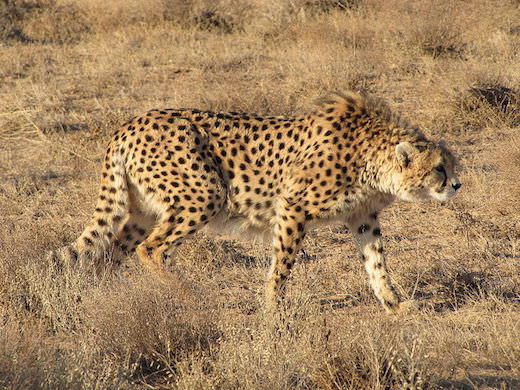Asiatic Cheetah

Critically endangered
The Asiatic cheetah is one of the world's most critically endangered big cats. Tan color, specked with characteristic black spots and weighing up to 143 pounds. Asiatic cheetahs are almost identical in appearance to their better known African cousins. However, there are subtle differences. Asiatic cheetahs are slightly more slender and have slightly longer legs. Moreover, because of the nature of these physical differences some have speculated that Asiatic cheetahs might actually be the faster than their African cousins. That said, as recently as 2009 it was argued that the Asiatic Cheetah was genetically identical to the African Cheetah. However, testing has since found that the two species are genetically distinct.
Population Distribution
The word “cheetah” actually comes from the Sanskrit (Indian) term 'chitrakam' meaning speckled, and unlike today the Asiatic cheetah was once prevalent on the Indian subcontinent. Indeed, the Asiatic cheetah once ranged all throughout India, Pakistan, Afghanistan and Central Asia. At present however, the Asiatic cheetah is believed only to survive in isolated parts of Iran. Sightings do still occur in Pakistan, particularly in Balochistan, though these can rarely be confirmed and are not believed to represent a resident or stable population.
Preferring Savannah like open plains and semi-desert regions, Asiatic cheetahs are presently found mainly in eastern Iran around areas such as Dasht-e Kavir, with most housed in protected national park habitats such as Kavir and Touran National Parks.
As for population density, populations of wild Asiatic cheetahs are often separated by significant distances. This is not however, due to naturally large roaming territories. Rather, the decline of Asiatic cheetahs' main sources of prey and encroachment of their natural habitat has lead to populations becoming isolated from each other. Meanwhile 2005-2006 figures for the total number of Asiatic cheetahs in the wild stand at just 50-60 with a recent survey only identifying 20.
Threats
Historically, man has been the main cause of the decline of the Asiatic cheetah. Uncontrolled hunting in Central Asia saw the Asiatic cheetah become extinct in Afghanistan in the 1950's and the last killed in Turkmenistan in 1984.
However, in India, Iran and Pakistan the chief cause of the Asiatic cheetah's decline has been the disappearance of its preferred prey. Preying on small antelopes the disappearance of these due to poaching and their being unable to compete with domestic livestock herds has lead to resultant declines in Asiatic cheetah populations.
Desertification of the Asiatic cheetah's already restricted habitat and urban and industrial development are also all leading factors in the species' continued decline. In Iran for example, the country's two main coal and iron mines are located in areas with the largest surviving populations on Asiatic cheetahs outside of national parks. Road building and infrastructure development in these regions has subsequently made the Asiatic cheetah more accessible to poachers. Moreover, between 2012 and 2013 it was discovered that two thirds of all Asiatic cheetah deaths in Iran were actually the result of road accidents.